02 May That there’s some corner of a foreign field…
An abandoned British cemetery in a remote part of Nandi Hills is a poignant reminder of former times
“If I should die, think only this of me:
That there’s some corner of a foreign field
That is forever England….”
~ “Soldier”, A poem by Rupert Brooke
Sometime during the 3rd Anglo-Mysore War (1790-92), which was fought between the armies of the East India Company under Lord Cornwallis (along with his Indian allies the Nizam of Hyderabad and the Marathas) and the mighty Tipu Sultan of Mysore, Bangalore was captured by the advancing British troops.
Having secured Bangalore, Cornwallis then turned his attention to the hill forts north of the city. These “droogs”, or precipitous limestone rocks hat punctuated the Mysore landscape, crowned with fortresses, were key defense bases for Tipu. And chief among them was the “towering fortress” of “Nandidrug” (or Nandidurga in the local language), described by the then Deputy Adjutant General…
“Nundydroog, the capital of a large and valuable district, is built on the summit of a mountain about one thousand seven hundred feet in height, three-fourths of its circumference being inaccessible, and the only face on which it can be ascended protected by two excellent walls, and an outwork which covered the gateway, and afforded a formidable flank fire. This fort….stood a siege worthy of the garrison which Tippoo had placed in it for its defence.”
In the “clear moon light” of the night of 18th October 1791, the East India Company’s army captured the strategically important bastion of Nandidrug. Once the war was over, and as part of the peace treaty which followed, the hill fort reverted to Tipu. But peace proved short-lived, and when hostilities broke out again in 1799 with the 4th Anglo-Mysore War, in which Tipu was finally defeated and killed in battle, Nandidurg and the surrounding plains once again came under the control of the British.
The village of Sultanpet and its abandoned British cemetery
In the same year 1799, by the foothills of Nandi Hills and below its fortress, the British stationed a garrison of troops in the small village of Sultanpet; ironically named in honor of Tipu Sultan, their late adversary, who first founded this settlement as a station on the steep path up to Nandidurg.
The British presence at Sultanpet, however, did not last long, as within about 20 years the garrison was relocated to the new cantonment town of Bangalore, and the troops moved on from this little village.
What the British left behind was a small cemetery, as a reminder of the English families stationed here at Sultanpet. Silent graves of soldiers and wives and children who had made the perilous journey to this small outpost and braved the dangers of living in this part of Southern India.
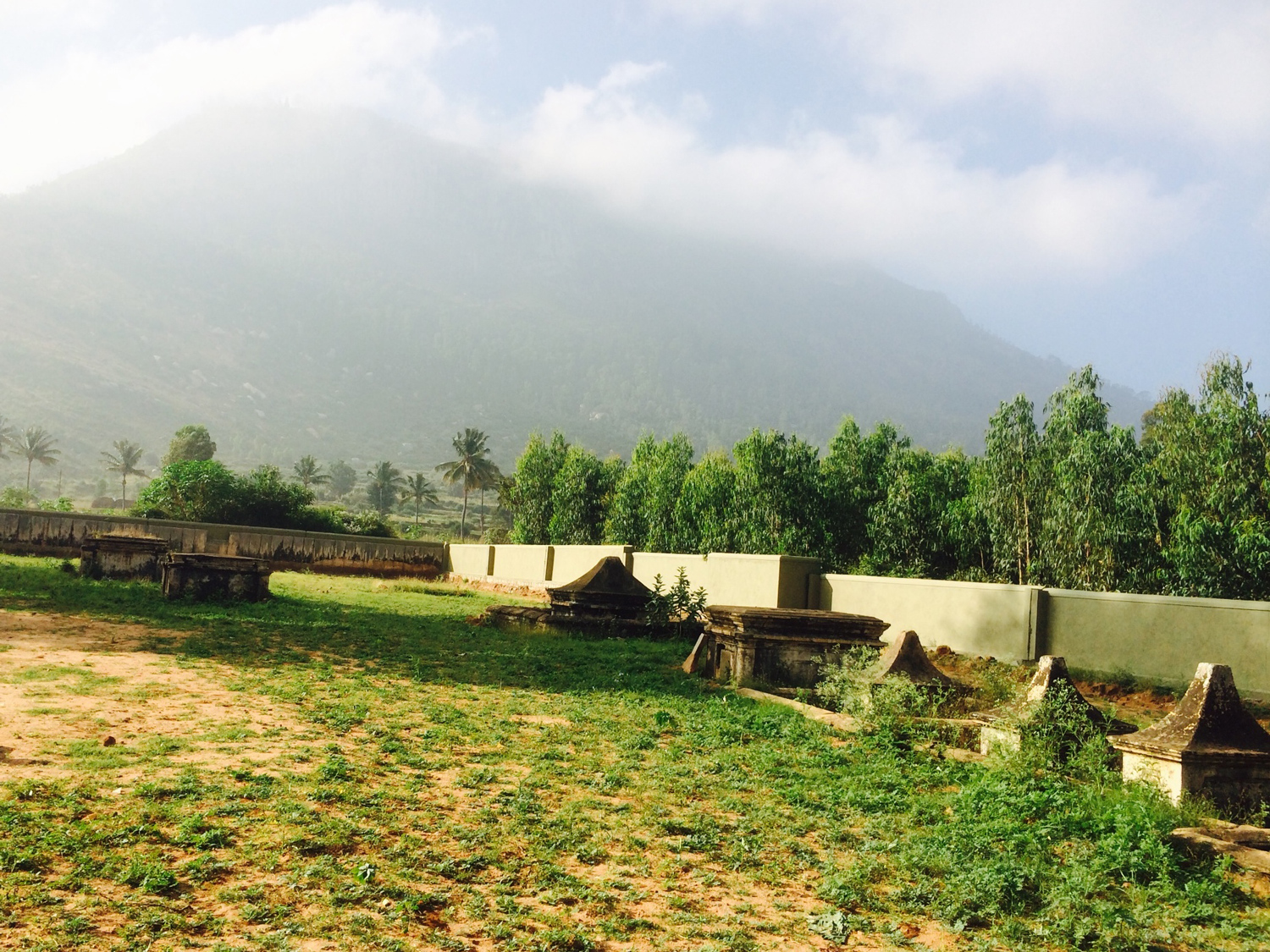 English soldiers, wives, children lie quietly beside the massive Nandidurg
English soldiers, wives, children lie quietly beside the massive NandidurgLocal conservation has kept alive this piece of history
The cemetery was officially abandoned in August 1963 by the British High Commission. . But thanks to the efforts of local residents (including the author of this article as well as the owner of a local resort and hospitality center, Mr. Prashanth Prakash of Discovery Village), the cemetery now has a boundary wall and metal fencing with a lockable gate to keep it safe.
Unfortunately, none of the tombs have much ornamentation left intact. Of a total of 12 graves, only 5 have inscription tablets are still in place, in granite. The choice of granite is not surprising given that this is the predominant rock in the area, with Nandi Hills being a granite monolith of real antiquity.
A description of the graves
The oldest grave in the cemetery is also the closest to the entrance and the road. Over the years, as the surrounding ground has risen, parts of the inscription has been buried. But it’s still clear enough to read :
“Sacred to the memory of Lt. Col. Ridgeway Mealy, who died on the 19th of August 1805 at age 44”.
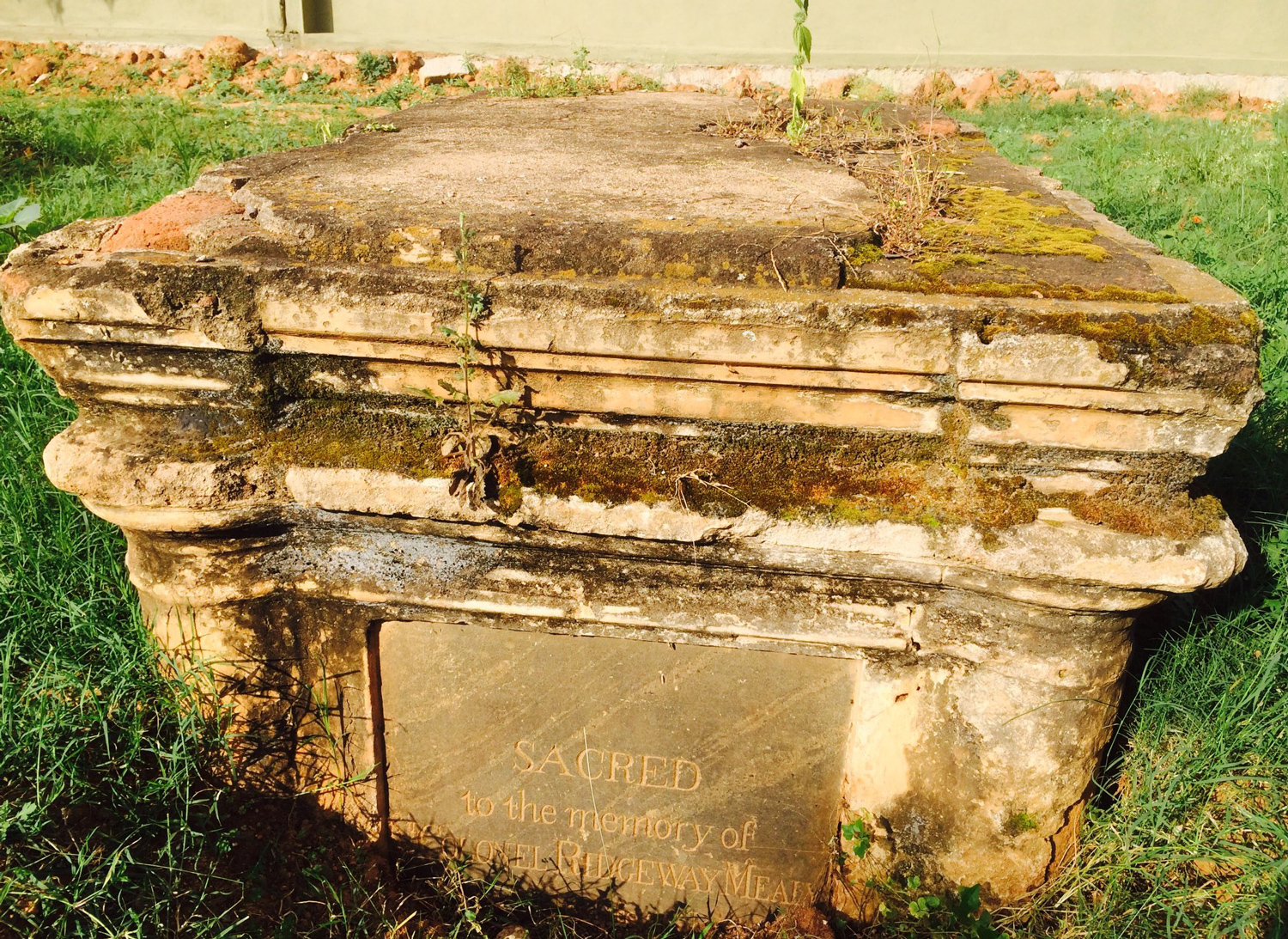 The oldest British grave at Sultanpet has its stone inscription still intact; Lt Col Ridgeway Mealy died 1805, at the age of 44.
The oldest British grave at Sultanpet has its stone inscription still intact; Lt Col Ridgeway Mealy died 1805, at the age of 44.
Amazingly, Professor Dr. Barry Lewis, Professor Emeritus of the Department of Anthropology, University of Illinois, has over the past decades been able to track down some of the descendants of those who are interred at the cemetery, including the relatives of Lt. Col. Mealy. As Professor Lewis puts it, “…the mere fact that we can talk with living relatives does make the people buried at Sultanpet seem more real and less like archaeological artifacts.”
Grave no.2 is just beyond, and is also intact thanks to a low parapet that surrounds it on all sides. The inscription reads :
“Here lie the remains of Elizabeth, the wife of William Prichard
She departed this life on the 1st Day of August A.D. 1807.”
E-mail from Prof. Dr. Lewis, dated 23rd December 2015
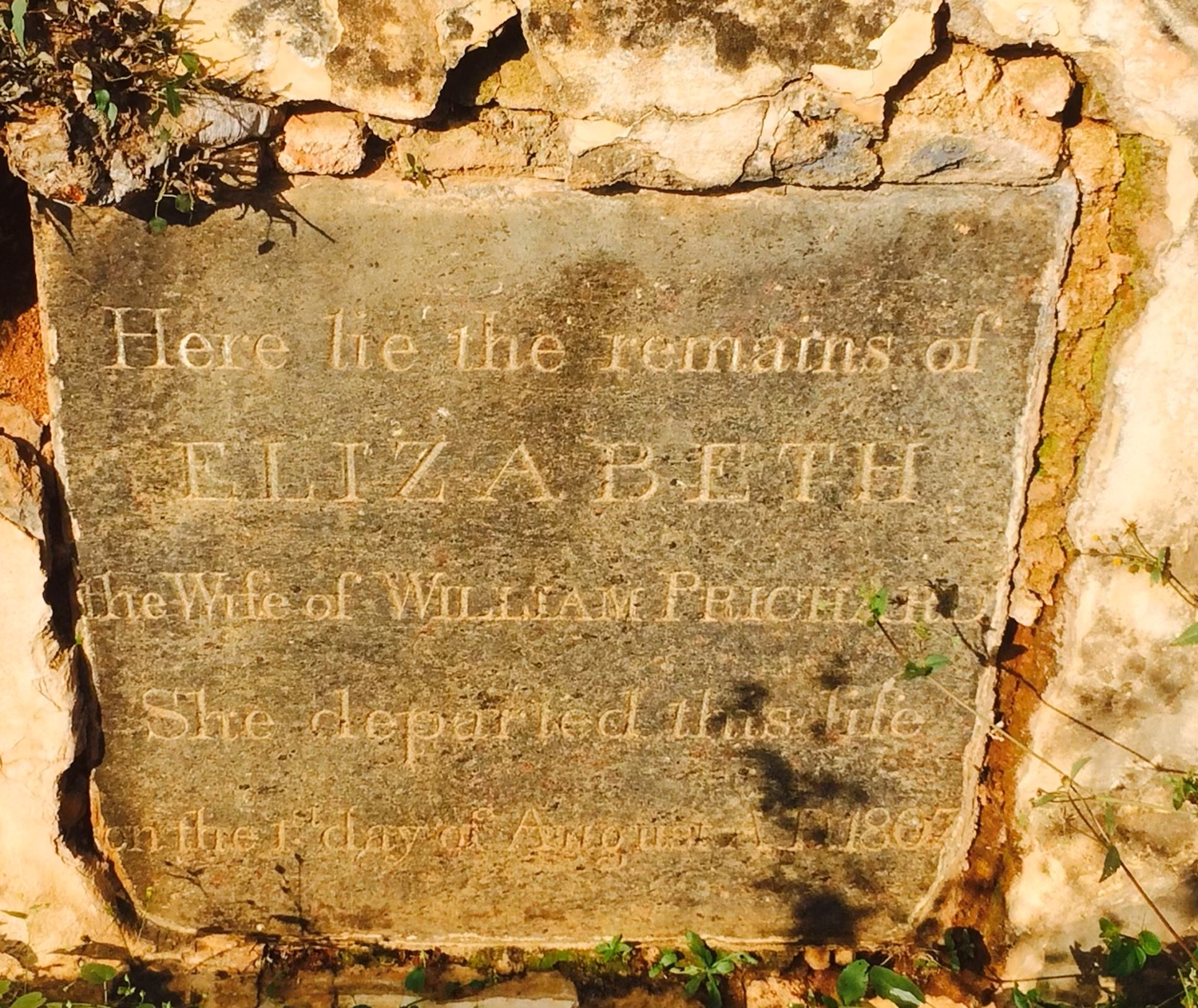 The grave of Elizabeth Prichard, died 1807, has a peepul tree sapling peeking out from a corner
The grave of Elizabeth Prichard, died 1807, has a peepul tree sapling peeking out from a corner
The graves 3 to 5 are smaller, and are obviously of children. They are missing any form of inscription tablets, but from the fact that they are arranged together within the same low parapet wall, could we infer that they belong to young siblings of the same family? Little brother or sisters who may together have faced an untimely death.
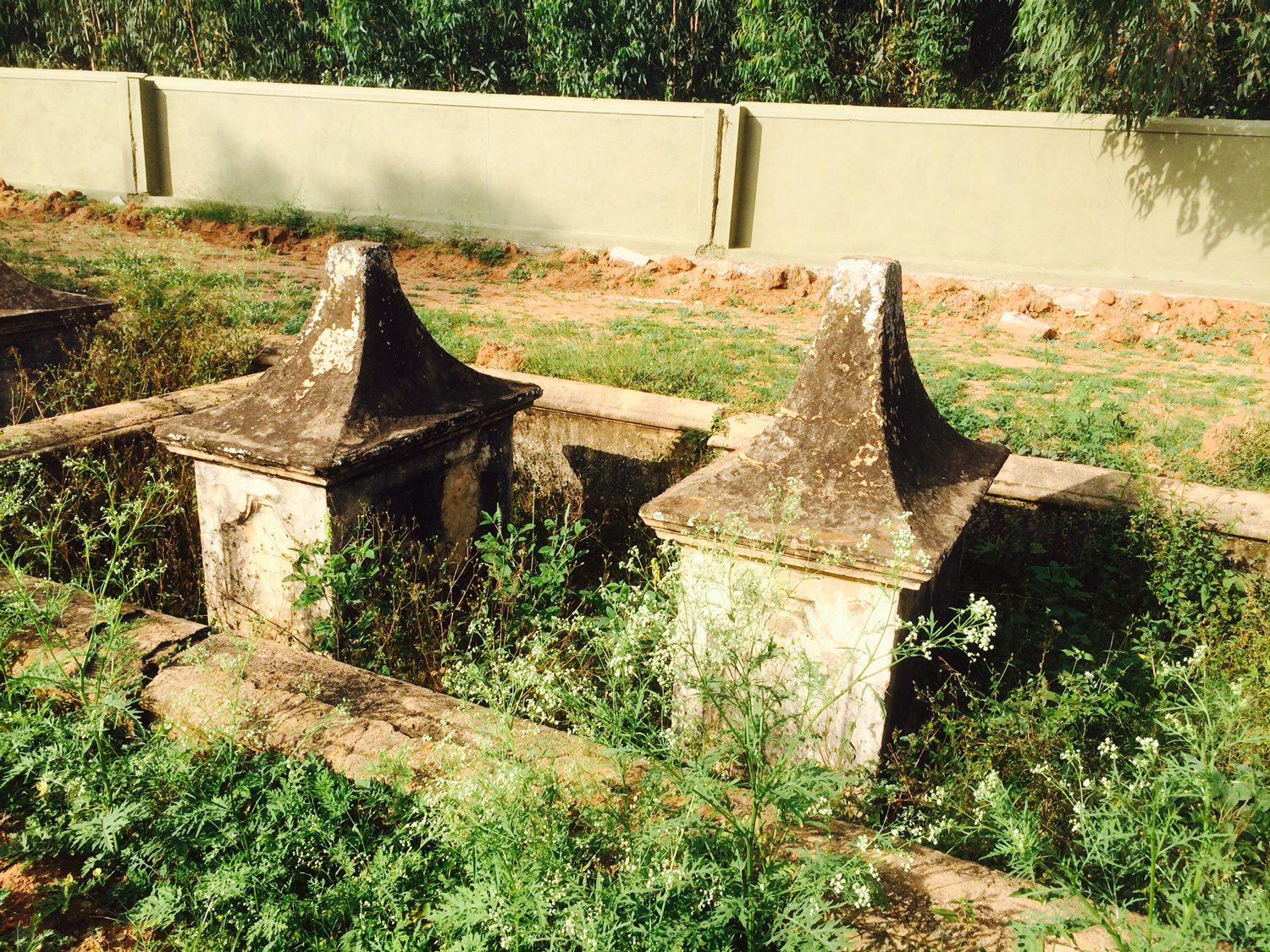 A clutch of 3 small graves of children who met untimely deaths in faraway Sultanpet…
A clutch of 3 small graves of children who met untimely deaths in faraway Sultanpet…Links with storied Infantry Regiments of the past…
Two of the graves within the cemetery are noteworthy for their links to famous Infantry Regiments from the past.
Grave no. 6, immediately next to the children’s graves, is…:
“Sacred to the memory of Lieut. James Sinclair, 2nd Battalion, 16th Regiment Native Infantry who departed this life on the 24th June 1813.
He died much regretted.”
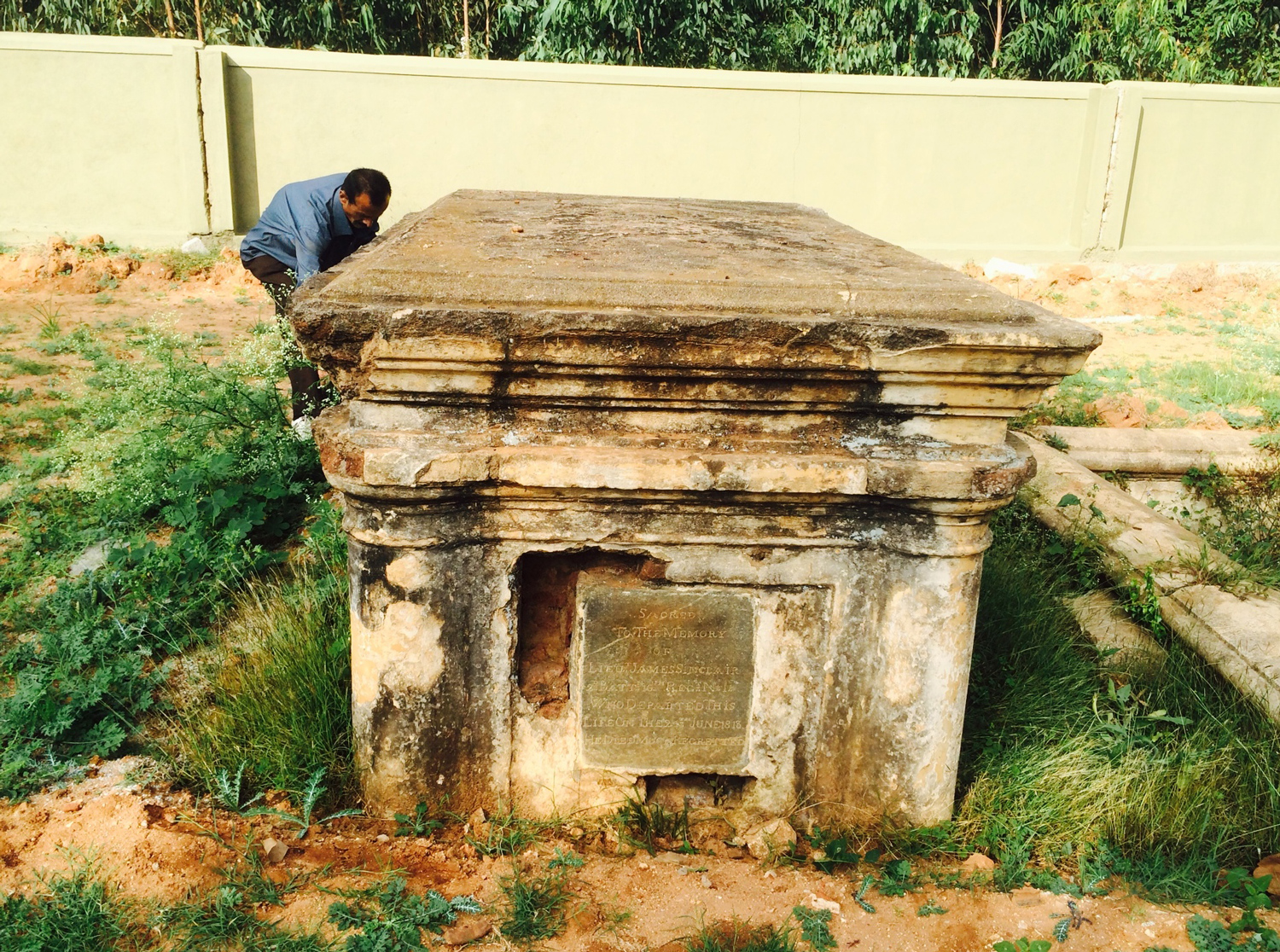 Lieut. James Sinclair of the Madras Native Infantry, which was several times reorganized to become today Pakistan’s Baloch Battalion
Lieut. James Sinclair of the Madras Native Infantry, which was several times reorganized to become today Pakistan’s Baloch Battalion
The reference to this Native Infantry is what is today the 4th Battalion of the Baloch Regiment of the Pakistan Army. It was first raised in 1800, largely comprising South Indian troops, as the 2nd Battalion 16th Regiment of the Madras Native Infantry (perhaps one of the first units raised by the East India Company). Later, in 1903, it was designated as the 92nd Punjab Light Infantry, and then again in 1922 as the 4th Battalion Prince of Wales’s Own 8th Punjab Regiment, before being absorbed into the Pakistan Army upon its formation in 1947.
The best-preserved tomb in the cemetery is grave no.7. It is also significant for the reason that the person interred here has a known modern day descendant – something which we have been able to join the dots on, based on the grave inscription, which reads as follows:
“Sacred to the memory of Major John Edward Gabriel of the Wallajabad Light Infantry
Who departed this life on the 23rd of March 1815 Aged 35 Years
This monument is erected as a tribute of affection and respect by his disconsolate widow.”
A certain Mr. Theo Flynn is the great-great-great grandson of the “disconsolate widow” Mrs. Harriet Court who married Major Gabriel on the 9th of June 1804 (she died on 14th January 1835).
The “Wallajabad Light Infantry” that Major Gabriel served, was raised in 1794 as the 33rd Madras Battalion and took part in the Battle of Seringapatam during the 4th Anglo-Mysore War. After several re-organizations it was renamed in 1811 as the ‘Wallajahbad Light Infantry’ – hence, the reference to Major Gabriel’s regiment on his gravestone.
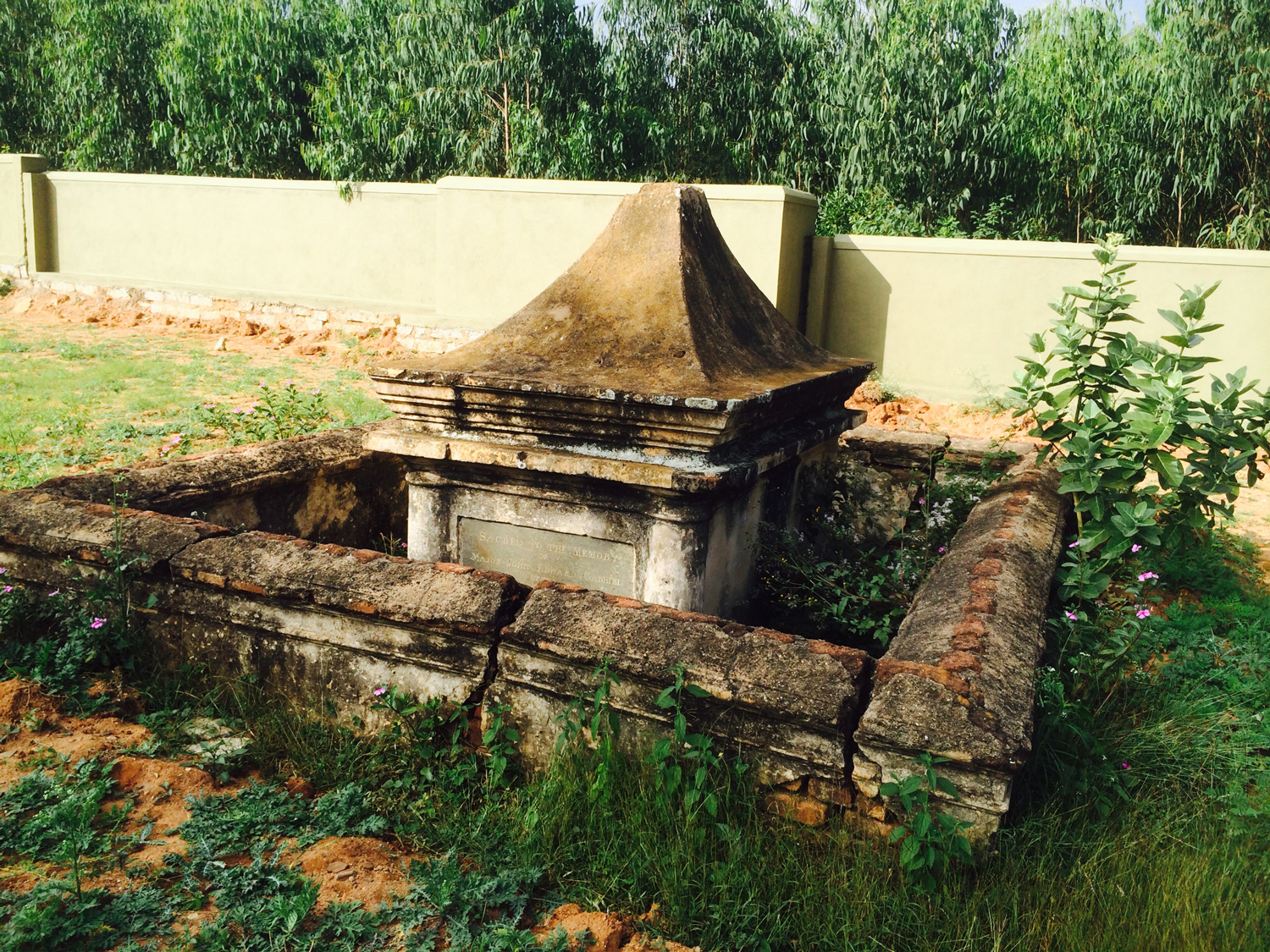 The best preserved grave in the cemetery has a known great-great-great grandson who has been traced!
The best preserved grave in the cemetery has a known great-great-great grandson who has been traced!“In that rich earth, a richer dust oncealed…”
The famous poem by Rupert Brooke goes on to read:
“There shall be in that rich earth, a richer dust concealed,
A dust whom England bore, shaped, made aware,
Gave, once, her flowers to love, her ways to roam,
A body of England’s, breathing English air,
Washed by the rivers, blest by suns of home”
Brooke wrote his poem in 1914, about the First World War. But his tender words touch the same emotional chords for these quiet souls, resting in a discreet corner of India, just north of Bangalore.
- Pgs 42 and 43, Major Alexander Dirom, A Narrative of the Campaign in India, which terminated the War with Tippoo Sultan in 1792, London: W. Bulmer and Co., 1793
- See, http://barry-lewis.com/research/cemeteries/sultanpet/, last accessed on 29th December 2015.
- E-mail from Prof. Dr. Lewis, dated 23rd December 2015.
- See, http://wiki.fibis.org/index.php/32nd_Regiment_of_Madras_Native_Infantry, last accessed on 28th December 2015.
- See, http://www.rootschat.com/forum/index.php?topic=557681.0, last accessed on 28th December 2015.
- See, http://wiki.fibis.org/index.php/23rd_Regiment_of_Madras_Native_Infantry, last accessed on 29th December 2015.
Sources:
- “Tiger of Mysore;The life and Death of Tipu Sultan” (Chatto and Windus, London. 1970); by Denys Forrest
- “A Narrative of the Campaign in India, which terminated the war with Tipoo Sultan in 1792”” (W Bulmer and Co); by Major Alexander Dirom
This article is by Siddharth Raja. A lawyer by profession and a heritage enthusiast by conviction, Siddharth lives in Nandi Hills, Bangalore and runs with his wife, Priya, a historical walking tour company ‘Nandi Valley Walks’ (www.facebook.com/nandivalleywalks).
